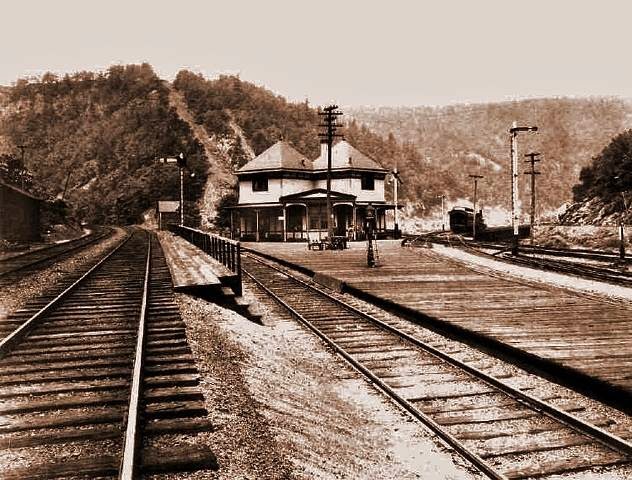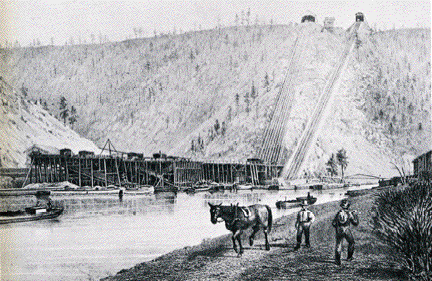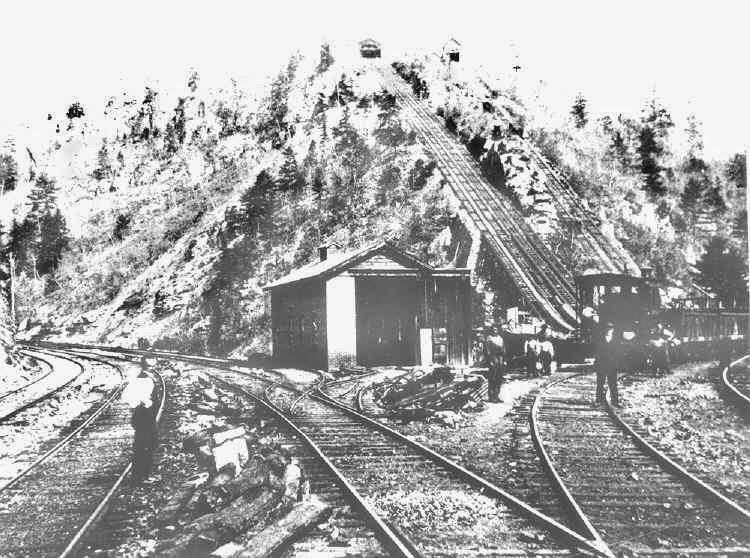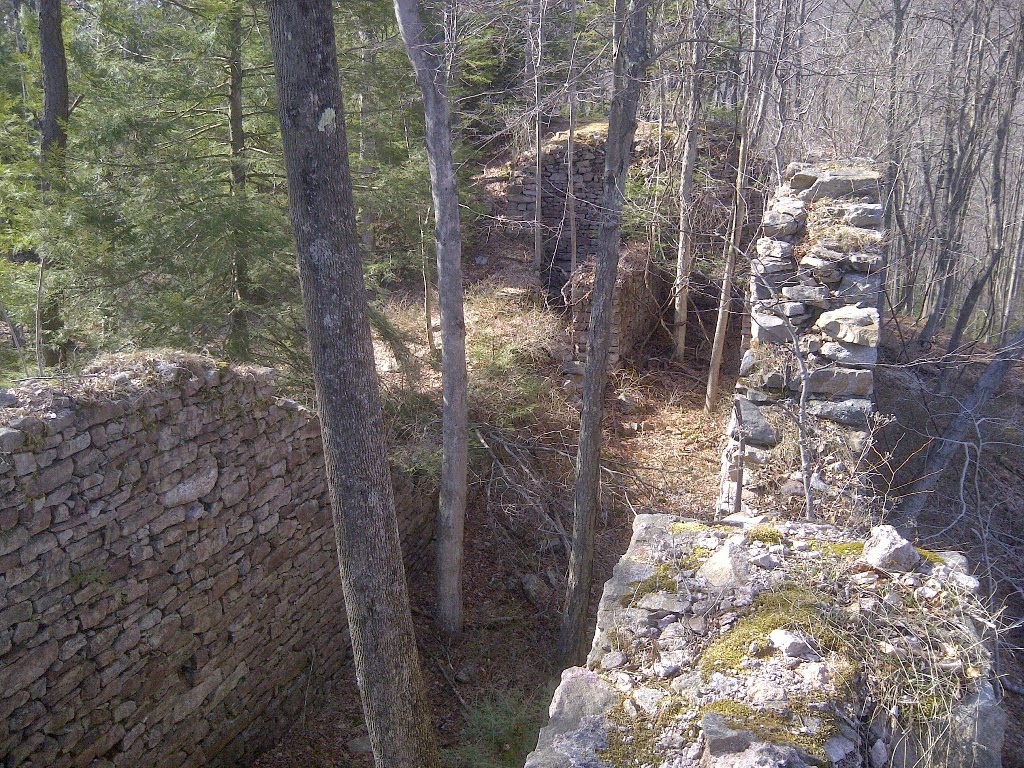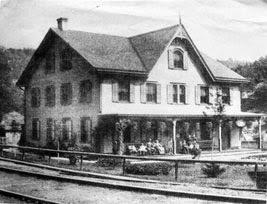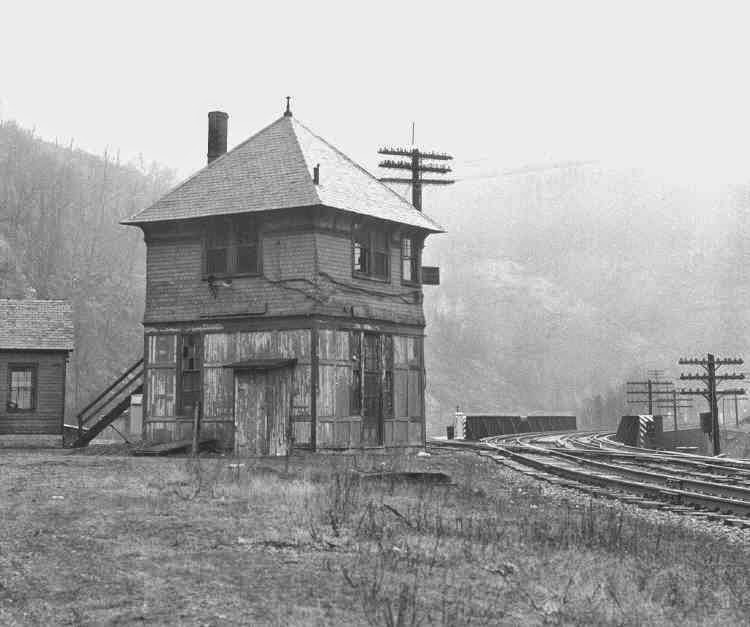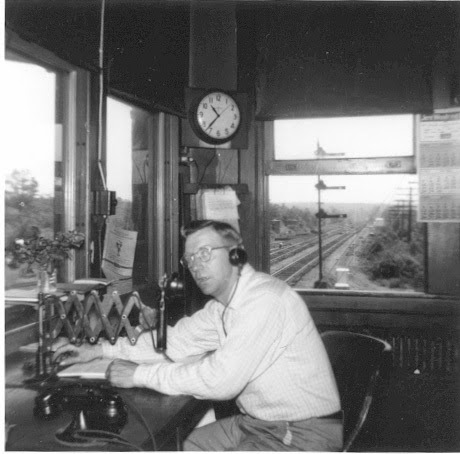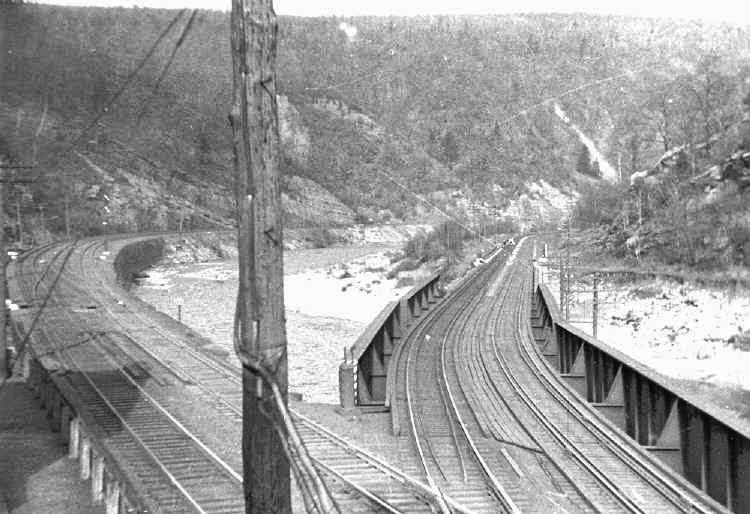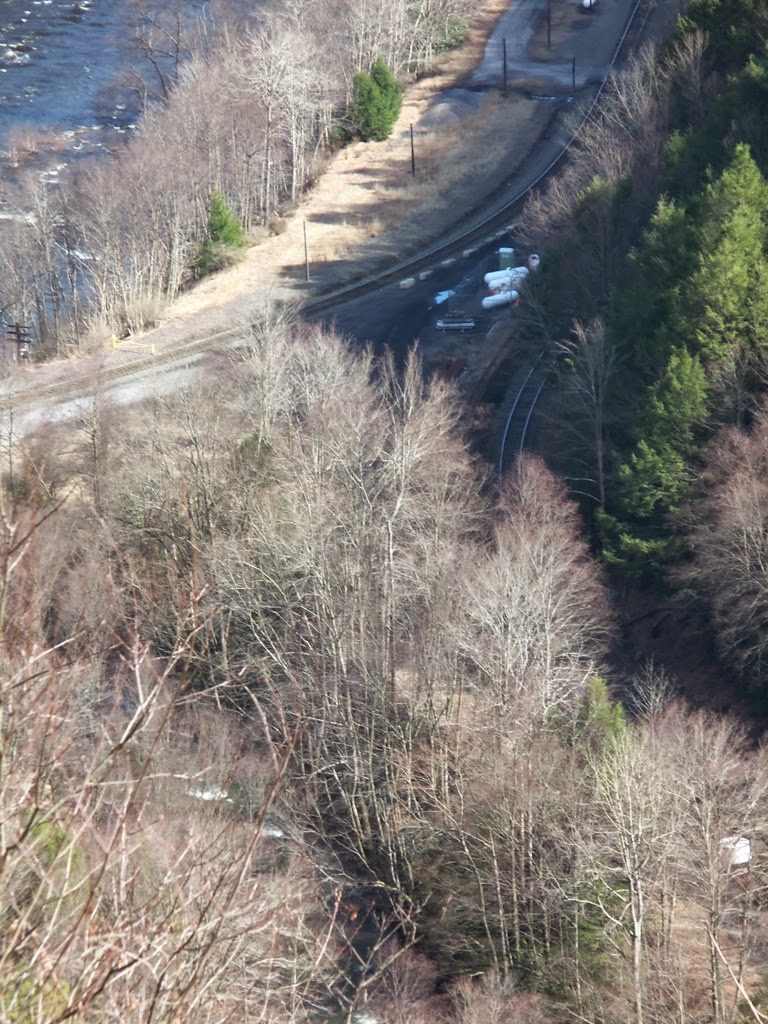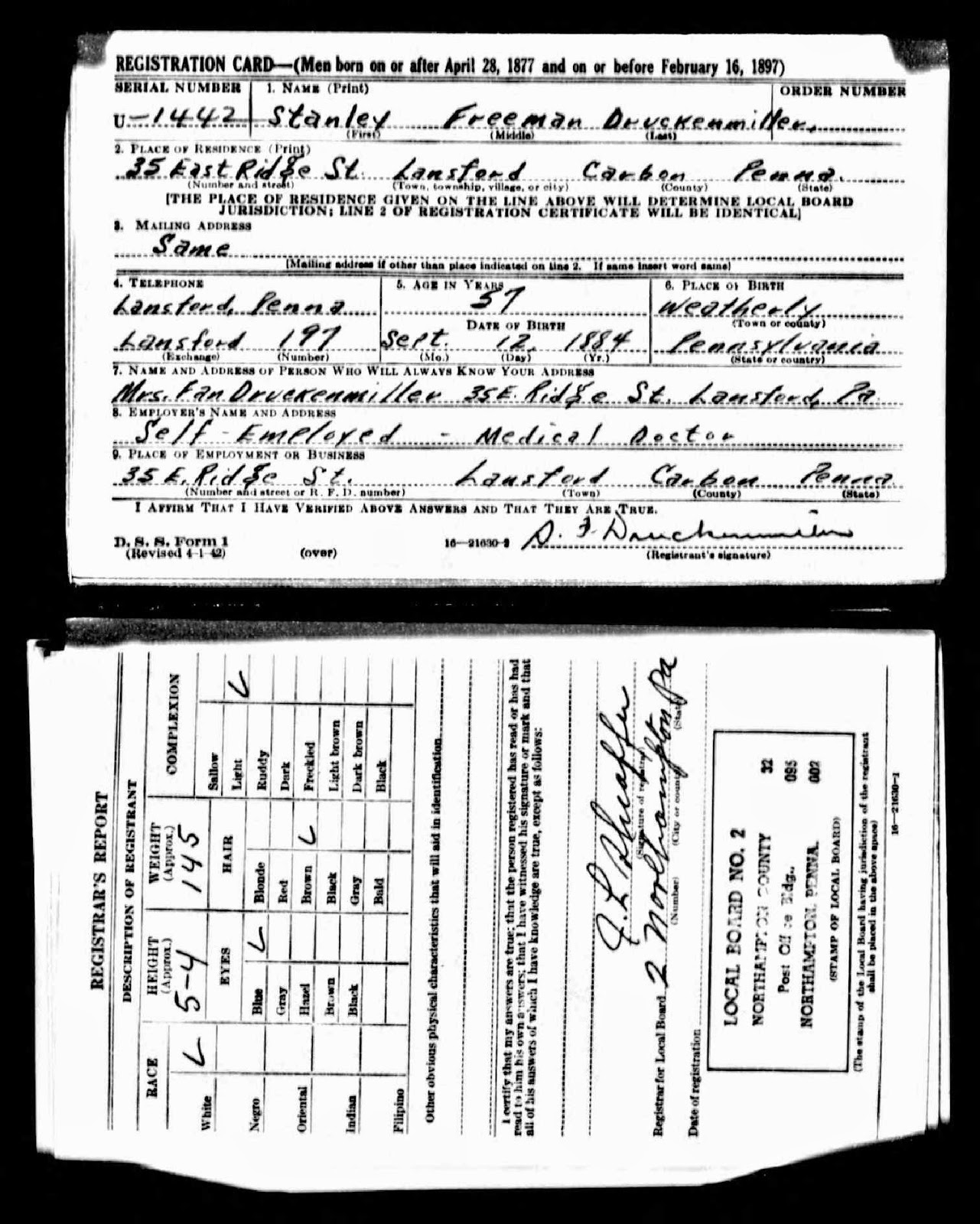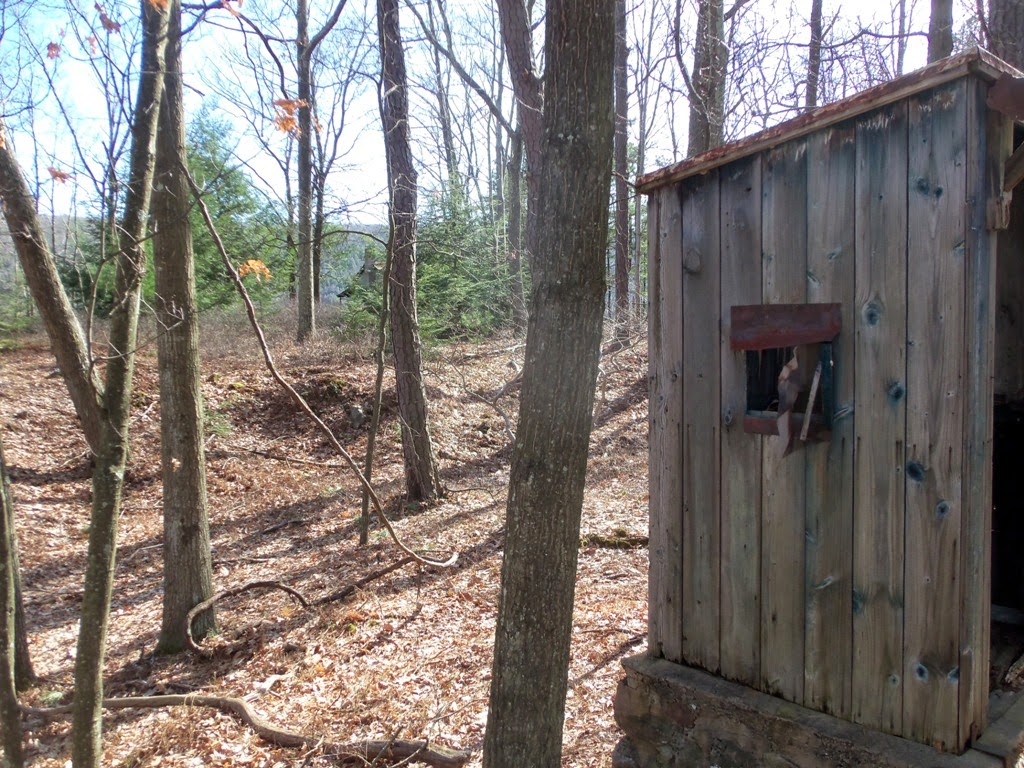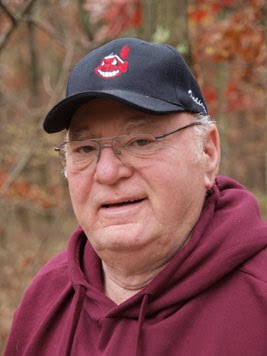THERE HAS BEEN A MAJOR SETBACK IN THIS POST - PLEASE STOP BACK BY FRI 1/10/13 - PICTURES WERE LOST AND NEED TO BE RELOADED..SORRY AND THANK YOU FOR YOUR PATIENCE - RJR
Originally built in 1901 at the Pan Am Exposition in Buffalo New York as the Michigan State Building, the stately manor was purchased by T. A. Snyder and transported to Lehighton piece by piece via the Lehigh Valley Railroad in 1903. This view is looking north across present day Iron St Lehighton. Seventh Street would be perpendicular to the left. The address of the current home is 638 Iron Street. (Photo courtesy of the Brad Haupt Collection.) |
|
The Michigan Building as it appeared at the 1901 Pan American Exposition in Buffalo, New York. |
The Colonial Court Mansion has intrigued many, mainly due to its high-colonial style and partly due to its mysteriously short life here in Lehighton. It once stood near the site of the assassination of President McKinley, brought her by T. A. Snyder by rail and hailed by historians as the "most beautiful home in the Lehigh Valley."
Theodore Allen Snyder came to the area at the youthful age of twenty to by the principal of the Lehighton Schools. He married a local girl, Miss Emma Hauk in 1879, and then returned to his hometown of Stroudsburg to pursue the study of law. Having passed the bar in Monroe County, he returned to Lehighton after 1883 to once again run the Lehighton Schools. By the age of twenty-eight, he became Superintendent of Carbon County’s Schools, the youngest in state history to hold such an office.
After his three, three-year terms, Snyder retired from the school business and established himself in the Carbon Bar. Along with his brother-in-law Atty. Charles A. Hauk, he opened up a law office in Lehighton. (Hauk was known to also have offices in Weatherly and Mauch Chunk as well.)
Snyder would become one of Lehighton’s key financial and land development pioneers. He served as solicitor and secretary to the boards of many key institutions. Among them were the Lehighton Savings and Loan and the Enterprise Building and Loan companies, the Lehighton Electric Power Plant and along with James Irwin Blakslee Jr, helped bring electric trolley service to the town.
He was the key player in the Lehighton Land Development Association that developed much of the agrarian land between Fifth and Tenth Streets.
The Pan Am Exposition of 1901:
By the time “T. A.,” as he was known, and his wife Emma attended the Pan American Exposition of 1901, he was a well-established, some say controversial figure in the economics and politics of the town. The Snyders were said to have “fallen in love” with the Michigan state building at the Expo, mainly because of its “lovely sweeping lines” of colonial architecture.
This world’s fair was meant to showcase the promise of the newly developed hydro-electricity generation of the Niagara Falls. An “Exposition Committee” was formed in 1897 to raise money and to select a site. There was stiff competition between holding it at Niagara Falls and Buffalo, New York.
Though Niagara was already a tourist mecca at that time, Buffalo edged them out with its transportation advantage. With a potential for the forty million visitors who lived along the rail lines connecting to Buffalo (including our own Lehigh Valley Railroad) to come to the Expo, the organizers wisely chose Buffalo. The 350-acre “Rumsey Property” was a twenty-minute trolley ride from downtown. The site was surrounded on three-sides by trolley lines, costing five cents for the twenty-minute ride from the train stations.
However the Spanish-American War interrupted the process in 1898, delaying the ground breaking until 1899. The Exposition started its six month run on May 1st, 1901. The grounds were covered with many grandiose, colorful buildings, giving the Expo the nickname “Rainbow City.”
The main structure was the 375-foot tall “Electric Tower.” There was the “Grand Canal” spanned by the “Triumphal Bridge,” U.S. Government buildings built to showcase the Navy, Post Office, Agriculture, Treasury, Patent office and etc.
The Aerio-Cycle was built at a cost of $40,000. It was a double-ended ferris-type wheel at each end of its 240-feet arm that articulated at an impressive 140-foot tall base and fulcrum. It was studded with over 2,000 light bulbs and used a forty-horsepower engine to lift the arm while a fourteen-horsepower engine at each end rotated the carriage. A ride on it cost as much as admission to the entire event: twenty-five cents.
There were ornate buildings dedicated to exhibiting the latest in
everything, from manufacturing to liberal arts, from agriculture to mining, from a 2,000 seat stadium complex to the “Art Building” to the “Ethnology Building” to the “Temple of Music.”
It was at the “Temple of Music” that on September 6th that President William McKinley was assassinated by Leon Czolgosz. Contrary to what many believe, Czogosz was not a foreign born terrorist. He was born in Alpena Michigan in 1873 to parents who emigrated here in 1860 from what is today Belarus. He had been caught up in anarchistic-mindfulness and was said to have shot the President because no one man should hold so much power while so many remain so powerless.
|
Leon Czogosz, a native born assassin was brutally beaten by the Secret Service, the Buffalo Police Dept. and others from the moment of his arrest to his day in court until the moment of his execution within a month of executing Pres. McKinley. |
Among the foreign countries to have buildings were Mexico, Honduras, Canada, and etc. Our new ally Cuba was also there as well as Ecuador, whose building was adjacent to the Michigan Building. Other states showcasing a building were: Illinois, New York, New Jersey, Ohio, Minnesota, Missouri, and others. The New England States produced one together while Alaska, then still only a territory, built a rustic pioneer cabin albeit a rather large one.
According to one source, “ninety-five percent of the buildings were built temporarily…built of chicken wire over wooden frames with a base coat of plaster.” Supposedly, many of these seemingly complex and ornate structures were badly deteriorating already by the end of the six-month run of the Expo.
The Michigan State Building:
The state of Michigan appropriated the sum of $43,000 to build, furnish, and occupy the building to receive a total of 500,000 visitors. Of those, 35,000 guests were from Michigan. (The Michigan Commission claimed their building “received more visitors than any other state building.”)
During its six-month life-span, it housed administrative and custodial staff including a full-time “house matron” (Miss Minnie Conger of Litchfield, MI).
One cannot help but notice the amount of pride the state of Michigan had for its efforts at the Expo. In their final report to their State House, they boasted that although they were “not the first state to break ground, but were the first to open doors.” They went on to say that their building was “one of the most attractive buildings on the grounds.”
The building cost $10,000 to construct and $3,424.29 to furnish. A relatively cheap price when compared to the New York building with a price tag of $375,000.
(One reason for this disparity in costs is attributed to the fact that the New York building was the only one built with the intent to remain permanently at the site. It was built with white Vermont marble and can be visited today as the Buffalo Historical Museum.)
The one-hundred foot long and eighty-one foot wide building was designed by Mr. Louis Kamper of Detroit and erected by G. J. Vinton & Co. also of Detroit. It was painted white, with fluted columns on three sides, with a shingled roof that was stained green.
The “imposing front” looked across the open court to the Lagoon and the Fisheries Building on the North. It was flanked by the New England Building on the west and the Ecuador Building on east.
|
This artist conception map done prior to the actual construction of the buildings shows the Michigan State catty-corner down and left from the "Indian Mound" at the top right of this picture. (This file appears courtesy of the Library at the University of Buffalo.) |
The entry opened up into a “spacious hall,” with a “ladies parlor” to the right and one for men to the left. Writing desks contained stationary for visitors to write home. There was an upright piano for entertainment. The gentleman’s parlor had heavy mahogany and leather furniture and the ladies’ side had rattan furniture.
Over fifty works of art were on loan and displayed throughout. The main hall had a “massive fireplace” and the rest of the first floor contained the secretary's office, the post office, a coat check room and two “toilet rooms.”
The second floor was done in Flemish oak with a writing room on the right and on the left the Commissioners’ room containing “every convenience.” There were also “private apartments” for the Secretary and his assistants on either side of the second floor.
The Wisconsin state building is one of two main buildings from the Expo that still exists. In comparison, Wisconsin claimed its building had a price tag of $35,000 to construct. They too claimed to be the first state building completed. (See the end of this story for more on this building’s history and how it looks today.)
Rise of the Colonial Court:
Except for the New York building, when the Expo came to its end in November of 1901, the remaining buildings were either to be auctioned off or demolished. The auction occurred in October of 1901. A man named James Hurd is said to have done the bidding for Snyder. The winning bid according to the Michigan State Commission report and other sources say the winning amount was $500. It was one of two buildings Snyder purchased that day.
Perhaps it was one of Snyder’s desires to one day serve as a judge in his adopted county, just as his dear friend and legal benefactor, the Honorable Judge Storm John B. Storm, did in Monroe County. (Snyder’s father served as Judge Storm’s “Court Crier.”) Snyder studied law under Storm and perhaps in deference to the life and death of his friend, Snyder wanted to bestow his home with the name “Colonial Court.”
The admission to the Expo at just twenty-five cents is roughly $9.oo today. And when one considers the telephone bill for the six months the building existed at the Expo to be $25.20, a bill for the ice used at $76.01, the $299.83 for postage, the $676.13 for printing and stationary, and a whopping $302.95 six-month electric bill, the cost Snyder paid truly was a remarkable bargain.
However, one should be careful for what ones wishes. It would be a remarkable discovery to find the bills associated with the de-construction, the transportation, and re-fabrication of this building, but no one seems to know.
The Michigan State Committee showed an expense of $356.68 for “packing and removal” which certainly only included the personal effects the committee needed to return to Michigan. One can only guess that the cost to dismantle the building alone was substantially more than any of the previously stated costs.
Sometime in early 1903, the pieces of the Michigan State building arrived at the Lehigh Valley Railroad’s freight terminal. At that time, Mahoning Street was not the east-west thoroughfare that it is today. The founding planners had intended for Iron Street to be that main route.
|
Here is an aerial shot appearing courtesy of Lamont Ebbert and Gordon Ripkey. Note Iron St in front of the mansion and Seventh St. to the left. In the foreground is the Lehighton Cemetery. Also note how agrarian the town was at the time. The rolling farm fields are now blocks and blocks of residential houses, in part due to the efforts of Theodore Snyder and his "Lehighton Land Development Company." |
Amid all the development deals Snyder laid out up to that point, he chose the corner of Seventh and Iron for himself and his new mansion. The aerial view of Lehighton, included here, shows just how agricultural the vicinity was in those days. The Snyder estate looked to encompass the entire block from Iron to Mahoning, from Seventh to Sixth streets.
The grounds were said to include gardens, a pond, and a zoo, replete with deer and peacocks. There was a barn known to house the several “fine horses” they owned, as evidenced in the picture with the young woman and carriage in front of the estate.
|
Judging by her age and stature, it is guess that the woman at the reins is T.A. Snyder's wife Edith. The horses do look to be of the finest breeding in the town, posing majestically in front an impressive piece of Lehighton real estate. The broad porches and "sweeping lines" are said to be what the Snyder's fell in love with. The woman on the porch seems to be proudly looking on. Photo appears courtesy of the Brad Haupt collection. |
It has been said that Snyder was quite fond of his deer and how close an attachment both animal and human had to the other. However, the legend goes on to say that on one rainy day, Snyder dressed in a floppy “rain hat and slicker” went unrecognized by his friends and was unexpectedly mauled by a protective buck. There is also anecdotal evidence of escaping deer creating excitement in town among the other residents.
Since the Michigan building was designed to house State Expo Commissioners for extended time periods, each of the seven bedrooms was built as its own apartment, each with its own attached bath. According to one website, the walls of most of the buildings were prefabricated and not intended for long-term use. It is unknown if the original interior design and walls were reused once in Lehighton.
|
Here is a picture from Eckhart's "History of Carbon County" as it appears on page 246 of volume 3. |
Viola (Miller) Fritzinger and her parents Charles and Phoebe Miller lived at the Mansion for a short time from 1915 into 1916. Viola was a young girl of twelve at the time and was interviewed by local historian Ralph Kreamer in the mid-1950s. According to Miller-Fritzinger, the walls had were “padded in pink brocaded satin” and there were hand-painted angels on the ceiling.
The ceiling of the wood-paneled library had coat of arms from famous families of the world painted on the ceiling. Given that there was nothing too particularly “Michigan” about the described interiors, it seems as though the Snyders gave these personal touches to the building themselves.
Snyder’s Demise Brings the Beginning of the End of Colonial Court:
It is unknown how long T. A. Snyder was feeling the effects of the tumor that was amassing on his liver. He traveled to St Luke’s Hospital in Bethelhem by rail on a Saturday and was operated on by Monday. He pulled through the operation well enough, but a “gradual decline” was noted.
By Wednesday the family was urgently called to be by his side. He passed that Thursday, May the 16th, 1907. The Central Jersey train brought his remains to town at 3:12 PM and his body was conveyed to his home for burial preparations.
He is buried at the Hauk-Snyder plot, the first plot straightaway as you enter the main gate of the Lehighton Cemetery.
|
The Snyder-Hauk family monument is the first obelisk that greets you as you enter the Lehighton Cemetery on Fourth Street. Note the horse stables of the Lehighton Fair Grounds to the west. The Colonial Court Mansion would be out of frame to the right. This is another photo of the Brad Haupt collection. Noting the large number of photos and artifacts of the Snyders and the Colonial Court, it would appear the original owners were good friends and possibly relatives of the family. |
Theodore and Emma had two children, son Raymond John Snyder was born May 15th 1882. Their daughter Edith May Snyder was born on January 11, 1884. As of the spring of 1910, Emma and her children were still living at 638 Iron Street. With them was a twenty-two year old live-in “servant” Miss Theresa Mery and a thirty-one year old “coachman” George Bonser.
According to one source, the Snyder family moved out of the estate prior to Emma’s death on June 2, 1915. By then Emma May had married Charles Fordyce Ames.
Sometime during the summer of 1915, perhaps a decision made by Raymond and Emma upon their mother’s death, they decided to lease their former family estate out to Charles and Phoebe Miller of Lehighton. Charles was an air brake inspector on the railroad and they hoped to live in fine style as well as operate the mansion as a boarding house.
Perhaps the venture wasn’t working out as planned for by the following spring, the Miller family only had one boarder, the remaining unused rooms being closed off. The sole roomer besides their hired “servant girl” was Robert Webb, a worker at the Eugene Baer Silk Mill three blocks below the mansion at the bottom of Seventh Street.
The Millers were looking to walk away from their lease in the upcoming summer.
Their moving plans however, were accelerated when a mysterious fire broke out one night in April.
The Fire:
Sometime around 1:30 AM, boarder Robert Webb was awakened by smoke pouring into his room from the closet of his second floor bedroom. He alerted the Miller family and the servant. The fire was said to be “coming from everywhere at once.” Miller returned back inside to retrieve a few possessions and nearly lost his life.
The two fire stations were only five blocks away. But the muddy spring streets hampered their efforts. Reports of the bright blaze came from far out the Mahoning Valley. All hopes at saving any of the iconic building died when the nearby fire hydrants gave forth little to no water, the pipes, like the streets were clogged with mud.
By 6:00 AM, the tall columns had fallen into the center of the smoldering remains of the fire and were burned.
The Current Residence:
By 1930, William S. Dreisbach and his wife Amaza “Anna” constructed a home on the site that remains to this day. Until recently, the residence was still adorned with the ornamental concrete orbs at the head of the walkway leading to the front of the Colonial Court.
|
This photo of the Dreisbach residence of at least sixty years ago, still has the concrete orbs that adorned the sidewalks of the original Colonial Court. The orbs are now gone, though the house can still be seen at Seventh and Iron Streets. Photo appears courtesy of the Brad Haupt Collection. |
From the Ashes?
As mentioned earlier, the Michigan State Building was not the only building purchased from the Expo by the Snyders. They also bought the Pennsylvania Building at auction. The common held belief is this building was never completely re-assembled here. Rather, pieces of it were used to rebuild the Flagstaff Mountain Resort of Packerton after it suffered a fire.
|
Here is one of the attractions that drove people to the Flagstaff Park and Resort that has provided the adventureous spectacular views from its summit for over 100 years. It was once a stop along the inter-urban trolley line between Mauch Chunk and Lehighton. It was also the final location for the second building Snyder purchased from the Pan Am Expo, that of the Pennsylvania Building. Photo courtesy of the Brad Haupt collection. |
There is also a rumor of note around town that the columns from the Colonial Court ended up in Weissport. If the above report is to be believed in all its literal sense, the columns were consumed by the fire, as some have maintained.
|
The Pennsylvania Building as it appeared at the Expo before Snyder relocated it to Flagstaff Park in his neighboring town of Mauch Chunk. |
However others have speculated that Dr. Haberman’s columns were indeed those from the Michigan Building. The timing of the demise of the Mansion and the construction of Haberman’s home somewhat coincides. The 200 Franklin Street home was built sometime after 1920.
The building remains in Weissport as the Mayes-Melber Funeral home. The columns origination still remains a mystery.
|
Could these be the columns saved from the Colonial Court fire? This is the former home of Dr. Haberman at 200 Franklin Street, Weissport, across the river from Lehighton. It is currently the home of Thomas and Mary Melber and is one location of the Melber Funeral Home. This photo appears courtesy of Tom and Mary Melber. |
Further Reading: Snyder-Hauk-Ames Family Genealogical Research –
The life of Theodore Allen Snyder took him many places, in many capacities. He was born to John and Francis Snyder in Stroudsburg on April 15, 1857. He was the oldest of four kids, two boys (William b. 1861) and two girls (Emma b. 1858 and Lizzie b. 1867). His father was at first a building contractor and lastly a court crier in Monroe County Court House. The latter position most likely from Theodore’s study of law under the Judge John B. Storm.
He graduated from Millersville Normal School at the age of sixteen and taught grammar school in Stroudsburg before becoming the principal of Lehighton’s schools at the young age of twenty.
On December 23, 1879, Theodore married the Miss Emma Hauk of Lehighton. She was the daughter of John and Ursula (Elsen) Hauk of Lehighton. John Hauk was a German immigrant who ran a bakery around 200 North First Street until his death in 1899.
Theodore and Emma had their first child Raymond John on May 15, 1882. Edith Snyder was born to them on January 11, 1884.
By 1883 they were living back in Stroudsburg where he studied law under Judge Storm and admitted to the Monroe County bar in 1883. Judge John B. Storm died sometime around August 23, 1901. He returned once again to Lehighton to be the principal of the Lehighton Schools in 1883.
Theodore, or “T. A.” as he was now known, is mentioned in at least one article as being “controversial.” Whether or not it was his first attempt at running for Superintendent of Carbon County Schools that earned this distinction is not known. In the Fall of 1884, he closed the Lehighton Schools for three weeks during what turned out to be an unsuccessful campaign. He did however mount a successful campaign in 1885, becoming the youngest County Superintendent in state history. He was twenty-eight.
He retired from the school system in 1893 and once again opened a law office the papers called “alike satisfactory and profitable.” He aligned his efforts with his confirmed bachelor brother-in-law Charles A. Hauk who had offices in Lehighton, Mauch Chunk, and Weatherly. Another foray that perhaps established him as among the wealthiest of town was serving on the boards and as solicitor on two building and loan Associations: The Lehighton Building and Loan and the Enterprise Building and Loan Associations. (Both of these institutions also had the either subsidiary or successor organizations of the same name but denoted with as “….Building and Loan #2.”)
There were many well-established business men in town directly involved on the boards of these institutions and who invested capital for their operation. It has been noted in the “Blakslee’s Trolleys” post of January 1, 2014 of T. A.’s involvement in the establishment of trolley service in town. In fact, in the year of his death, he was once again nominated to that entity’s board.
He was also a member and driving force on Lehighton’s Land Development Company, the one that established the uncharted lands of Lehighton between Fourth and Tenth Streets for residential development. Previous to this time, save a few scattered homes, the majority of this property was largely agricultural in nature, as evidenced by the few barns and out buildings still in existence there today.
Just below the Colonial Court, Small and Koch’s Dairy operated between Bridge Street between Seventh and Ninth Sts around this time. It later evolved into Gerstlauer’s Dairy. Currently that property is run as Zimmerman’s Dairy today.
One small evidence of the Theodore and Emma’s emerging wealth was evidence by the 42nd birthday party he hosted in April of 1899. In the absence of electronic entertainment or even records, the Snyder’s and the vast gathering of friends enjoyed the sounds of “G. C. Clauss’ Mandolin Orchestra.” The papers said the “banquet surpassed anything in that line ever given by an individual in this town.” They also mentioned that his friends are still speaking of his hospitality in “glowing terms.”
Glanville Clauss was offered $100 if he refrained from touching even a drop of alcohol until his twenty-first birthday. The Lehighton Press announced his success in this endeavor in April of 1894.
Both he and Atty. Charles Hauk were talented musicians who played a variety of instruments at many family functions for people of the town. “G. C” was known to also play piano and one a humorous solo performance that left the crowd in a hypnotic trance. Both he and Hauk performed bag pipe solos and performed a stirring rendition of the “Ice Song.”
The Hauk Family:
After John Hauk Sr. died in January of 1899, his wife Sarah (Elsen) Hauk continued to manage the family bakery business. Still living at home with their sixty-three year old mother were Miss Agnes Hauk, a public school teacher born in 1861.
Charles A. Hauk, born in April of 1870, was listed as a thirty-year old “student,” most likely studying law at the time. The youngest, William E., born in May of 1877 was also a student, attending the University of Pennsylvania on his way to opening a dental practice in Duquesne, Pennsylvania.
Today, we still know of Charles’s penchant for remaining single, at least that is how the papers painted him at the time of Dr. Hauk’s wedding in April of 1909. As Charles was serving as his brother’s best man, the paper playfully suggested that “C. A.” stood in “fear and trembling,” should the Bishop make a mistake and ask him to “renounce all others and cleave only to one.” Thereafter joining the “Army of Benedicts” (an expression for a man who gets married) Dr. William Elsen Hauk and the former Miss Mabel Botkin of Duquesne honeymooned in the Bermuda Islands.
The offspring of Theodore and Ella (Hauk) Snyder:
Raymond John Synder born May 15, 1882 is perhaps the same Raymond J. Snyder who attended Lafayette College in Easton PA in 1903, a member of Sigma Nu fraternity. At about the time of his mother’s death, he was living at 242 North First Street in Lehighton as a “self-employed newspaperman.” He died in San Francisco on September 22, 1949. No further details of a family of his own are known.
Edith May Snyder Ames was born on January 11, 1884 and married Charles Ames of Brooklyn New York. Charlie and his father owned “Ames Hydrovauc” in the city. They had two children, Louisa Ames born in Georgia in 1913 and Charles born in 1921. By 1940, Louisa was married to a Robert Farren in Springfield Massachusetts. Her nineteen year old brother Charles Jr. was living with her and her family. He was working as a “physicist’s assistant” at the Springfield Armory.
Edith Snyder Ames died when Charles Jr was just one year old on March 2, 1922. She is buried alongside her mother. Her children and husband are buried elsewhere.
Viola Miller, the daughter of the Colonial Court’s last residents later married Rollin Fritzinger of Lehighton. He was an insurance agent in town. Rollin died in July of 1986 and Viola followed him in May 1987. She was the last known person to have lived in the mansion.
Though once distinguished families of import to the formative years of Lehighton’s settlement, it appears little is known or written about of the Hauk-Snyder families. For as prominent they once were here, there is scant little written about them on the genealogical sites. Perhaps a descendent will read this post and help fill in the lines of information these families deserve.
One Last Thought:
No one knows how much interest there’d still be if the Michigan State Building/Colonial Court Snyder Mansion still stood here in Lehighton. Among all the major buildings from the 1901 Exposition, all are gone but two. The first as previously mentioned was the New York building built permanently at the site. The other building, the Wisconsin State Building still stands in Port Abino, Ontario.
|
The Wisconsin Building as it appears today as a summer home in Port Abino, Ontario. |
Legend has it that a Buffalonian named Henry Dickinson transported it across the frozen Lake Erie in forty-seven hay-wagons. It is not known if the lake froze that year.
The owners of the now summer home along the Canadian shore have received frequent inquiries from curiosity seekers from the 1901 Exposition over the years.
|
A crow atop the Snyder-Hauk Monument in Lehighton Cemetery. |
We can only imagine what stories of the Colonial Court could still be reverberating here, had Lehighton’s showpiece from that time and place still remained.
Special thanks to Lamont Ebbert, Gordon Ripkey and my sister Rebecca Rabenold-Finselfor their assistance with this piece. Also, I’d like to show my gratitude for the 1955 article on the Mansion written by the late Lehighton historian Ralph Kreamer: Your work has have survived, and both you and your words have entered the cyber world dear Ralph!















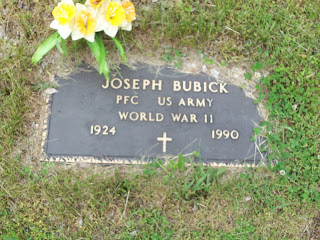

















.jpg)














































































































+wiki.jpg)














































































